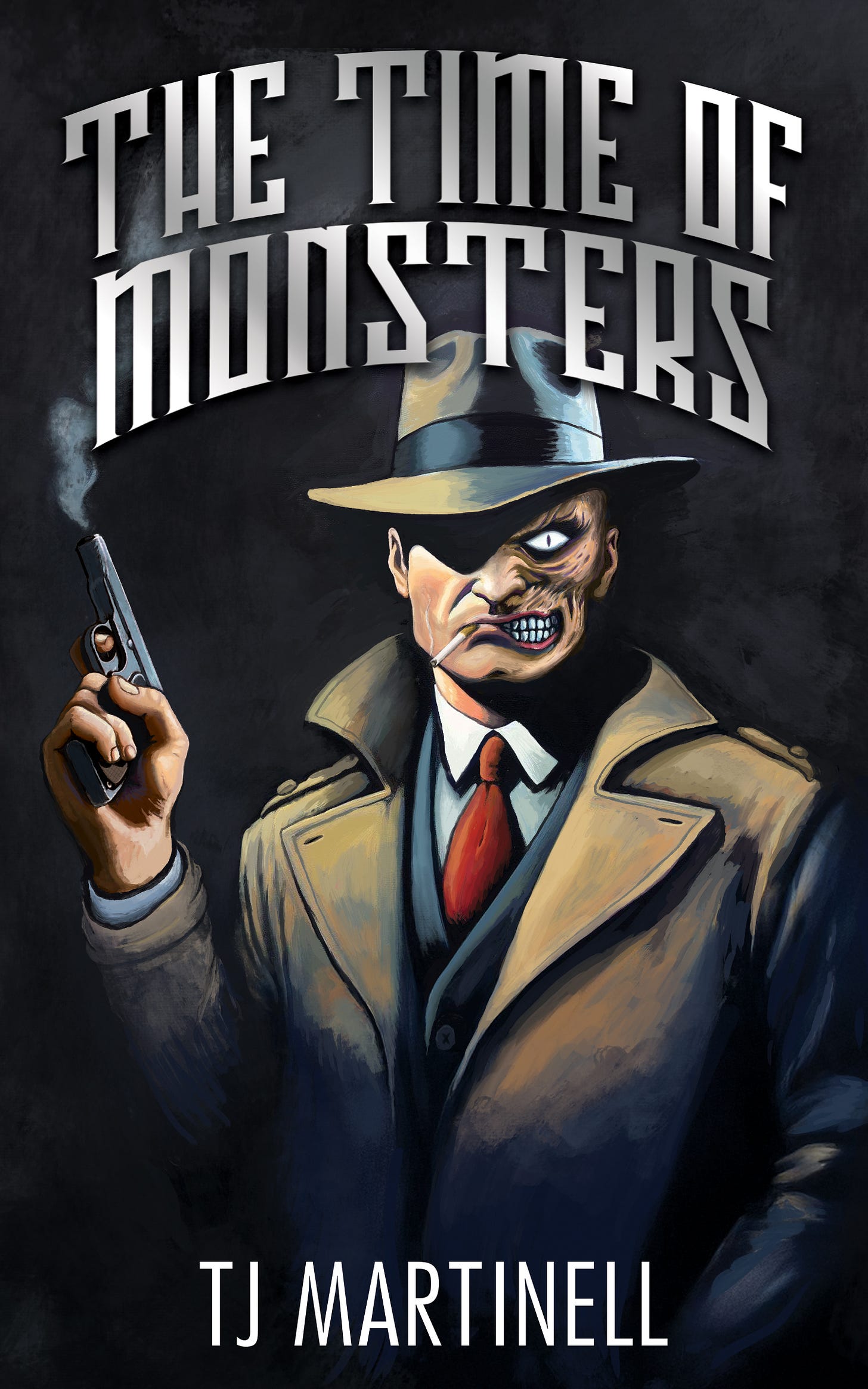Two Guys, Two Guns, & A Bunch of Dead Commies
A Review of T.J. Martinell's "The Time of Monsters"
In case you haven’t heard, Bizarchives veteran and editor Arbogast has his own publishing company. 1325 Publishing hopes to be a small, but potent force in indie publishing, and already the imprint has completed an occult detective short story contest and published The Return of Patrick Midnight. 1325’s latest volume, T.J. Martinell’s The Time of Monsters, should be a surefire hit for all the pulp lovers here on The Obelisk.
A sequel to last year’s The Shadow Men (the last book ever published by Terror House Press), The Time of Monsters picks up where the previous action ended. So, yes, you do have to read the first book if you want a complete understanding of this most recent volume. However, there is enough action and intrigue that The Time of Monsters can stand on its own. Suffice it to say that all you have to know is that the two lead characters—John Savage and Marlon Trent—once worked for the shadowy STIGMA organization. From the U.S. war in the Philippines until the Great Depression, STIGMA was a private intelligence agency headquartered in New York City, and its mission was simple yet brutal: eliminate communist ideology and its adherents from the United States. However, sometime around 1929, STIGMA was infiltrated by a lethal Soviet agent named Alexander Shukov Malchev, who, after surviving an assassination attempt by Savage and Trent, changed his name and became a member of the U.S. Senate. From this position, Malchev won big money backers, and these backers unwittingly financed his plan to subvert and ultimately take over the U.S. government in the name of Bolshevism.
The Time of Monsters begins after Savage, Trent, and a handful of others have been excommunicated from STIGMA by the new regime. Not content with retirement, Savage and Trent go to war against Malchev, his backers, the turncoat General Villard, and the skin-crawlingly gruesome Dr. Archon. The latter fiend is responsible for the development and deployment of the fearsome Zarastran—a mind-altering drug that turns STIGMA agents into killing machines that cannot feel pain. The new STIGMA controlled by Malchev (known officially as Senator Kessler) wants to unleash Operation TARQUIN, which will see the deployment of Zarastran-infected STIGMA agents carrying out a quiet coup against the Roosevelt administration. Malchev wants to keep Roosevelt as the face of the American government, but he and his wealthy patrons will be the ones really running the show. Basically, Operation TARQUIN is the Business Plot, but left-wing and communist.
Savage and Trent’s goal in The Time of Monsters is to halt Operation TARQUIN and eliminate its core conspirators. Eradicating Zarastran is also a must, for some of Savage and Trent’s allies (most notably the unkillable former STIGMA man Anthony Wayne) require an antidote to the powerful intoxicant. Joining this mission is the wild man Barrett, a former STIGMA operative and Southerner who learned about Malchev’s machinations before the others. As a team, Savage, Trent, and Barrett prove incredibly dangerous, and The Time of Monsters is jam-packed with explosions, prison escapes, shootouts, and bloody interrogations, most of which see Malchev’s men on the wrong end of bad events.
The one thoroughgoing theme of the novel is Savage’s willingness, or rather unwillingness to engage in total war against the communists. Trent has no such qualms, and we see him coldly kill civilians in the name of taking out Malchev’s allies. Savage, on the other hand, wants to fight monsters without becoming one. For Trent, Wayne, and Barrett, it’s already the time of monsters, and all violence is justifiable in the name of stopping Operation TARQUIN. Eventually, after Wayne seemingly betrays everyone and kidnaps Trent, Savage and Barrett have to bring one of the founders of STIGMA out of retirement. Everything comes to a gory head at STIGMA headquarters, as Savage, Barrett, and Ewen (the man who trained them all) use their pistols and fists to kill everyone, even Zarastran-enhanced super-soldiers. Nobody save a few make it out alive.
Martinell, who works primarily as a reporter and journalist in Washington State, has a semi-purplish way of writing. His prose is not staccato, nor Hemingway-lite; Martinell loves adjectives, adverbs, and richly describing everything from the ambience to the shape of the buttons on a character’s coat. In this regard, Mr. Martinell is true to the pulp style, and The Time of Monsters certainly reads like something from the 1930s. The same is true for The Shadow Men, while Mr. Martinell’s other fantastic book—2020’s The Pilgrim’s Digress—is a little more contemporary. This neo-pulp style may ruffle some feathers, and it is certainly true that there are portions of The Time of Monsters that drag a little due to an over-emphasis on explaining the intricacies of firearms or the shared histories of the characters, but overall, the novel sails well. This is a quick read, and a fun one. Martinell has created quite the world in these two novels, and it is a safe bet that there are more STIGMA adventures planned ahead.
The Time of Monsters is currently available in paperback and Kindle.





Thanks for the review! I'm glad you enjoyed it.
As you observed, the writing style is very different from Pilgrim's Digress, in part because The Shadow Men and Time of Monsters were some of my earliest fictional projects I started in 2006 and 2008.
"it is a safe bet that there are more STIGMA adventures planned ahead."
Incidentally I didn't have anything planned, but after reading this review I started brainstorming and have an idea for a follow-up adventure. Stay tuned!